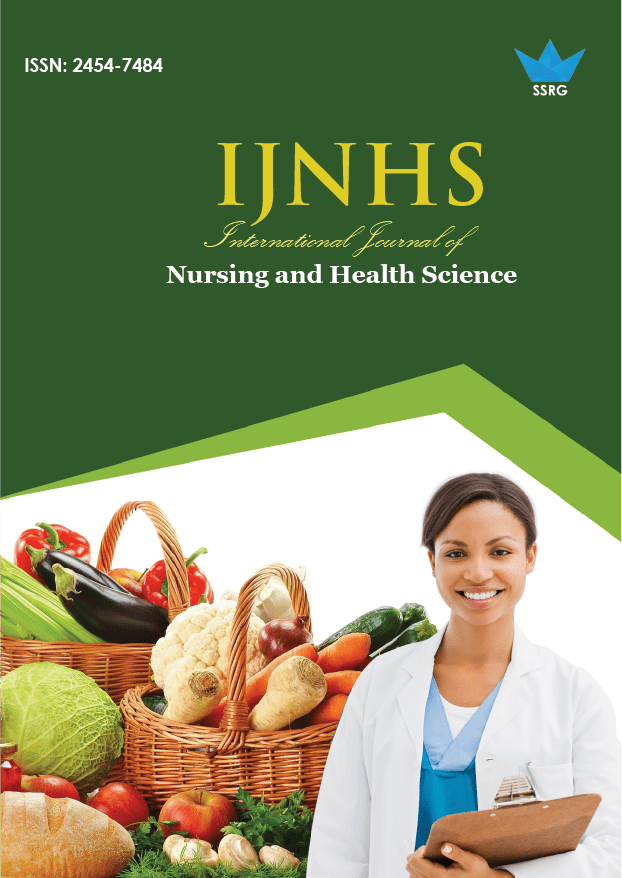Concept Analysis of Geriatric Sarcopenia

| International Journal of Nursing and Health Science |
| © 2017 by SSRG - IJNHS Journal |
| Volume 3 Issue 1 |
| Year of Publication : 2017 |
| Authors : Shu-Fang Chang |
How to Cite?
Shu-Fang Chang, "Concept Analysis of Geriatric Sarcopenia," SSRG International Journal of Nursing and Health Science, vol. 3, no. 1, pp. 5-8, 2017. Crossref, https://doi.org/10.14445/24547484/IJNHS-V3I1P102
Abstract:
A. Aim: This study aims to conduct a concept analysis of sarcopenia in the nursing profession.
B. Background: Older adults are prone to muscle loss and atrophy. They are likely to develop sarcopenia. Studies have indicated that the mortality rate of older adults with sarcopenia is one to five times higher than that of those without sarcopenia.
C. Introduction: The World Health Organization indicated that frailty prevention is a crucial indicator of successful aging. Frailty in older adults is determined primarily by mobility, which is expressed by the function of the muscular system. In addition, the annual medical expenditures caused by sarcopenia in the United States are estimated to be US$11.8 billion to US$26.2 billion. Thus, analysis and clarification of sarcopenia are required to assist nurses in deeply understanding this disease, allowing for the development of prevention strategies.
D. Methods: Walker and Avant's approach of concept analysis was used.
E. Results: This study confirmed the conceptual meaning and the signs and symptoms, introduced cases, identified causes and consequences, determined empirical indicators, reviewed the nursing literature, and investigated the practical aspects of sarcopenia for nursing.
F. Discussion: Through concept analysis, the difference between sarcopenia and other concepts was completely clarified by the nature of sarcopenia, the occurrence of sarcopenia, and the impact of sarcopenia.
G. Conclusion and Implications for Nursing and Health Policy
The objective of this study was to enhance nurses’ understanding of sarcopenia and their ability to actively develop comprehensive nursing care plans,
including regular exercise (particularly resistance exercise) and protein supplements. The ultimate goals are to reduce sarcopenia symptoms and prevent deaths caused by sarcopenia, which are critical to future older people care.
Keywords:
sarcopenia, geriatric syndromes, concept analysis, geriatric nursing
References:
[1] Baumgartner, R.N., et al., Epidemiology of sarcopenia among the elderly in New Mexico. American Journal of Epidemiology, 147 (1998) 755-763.
[2] Chang, S.F., Sarcopenia in the elderly: Diagnosis and treatment. The Journal of Nursing, 52 (2014) 1362-1374.
[3] Chang, S.F. & Lin, P.L., Frail phenotype and mortality prediction: a systematic review and meta-analysis of prospective cohort studies. International journal of nursing studies, 52 (2015) 1362-1374.
[4] Chen, C.Y., NHRI researchers report thigh muscle volume predicted by anthropometric measurement correlates with physical function in older adults. National Health Research Institutes Newsletter, (2010) 372.
[5] Chen, L.K., et al., Sarcopenia in Asia: Consensus report of the asian working group for sarcopenia. Journal of the American Medical Directors Association, 15 (2014) 95-101.
[6] Cruz-Jentoft, A.J., et al., Sarcopenia: European consensus on definition and diagnosis Report of the European Working Group on Sarcopenia in Older People. Age and Ageing, 39 (2010a) 412-423.
[7] Cruz-Jentoft, A.J., Landi, F., Topinková, E. & Michel, J.P. Understanding sarcopenia as a geriatric syndrome, Current Opinion in Clinical Nutrition & Metabolic Care, 13 (2010b) 1-7.
[8] Janssen, I., Heymsfield, S.B. & Ross, R., Low relative skeletal muscle mass (sarcopenia) in older persons is associated with functional impairment and physical disability, Journal of the American Geriatrics Society, 50 (2002) 889- 896.
[9] Landi, F., et al., Sarcopenia and mortality risk in frail older persons aged 80 years and older: Results from ilSIRENTE study. Age and Ageing, 42 (2013) 203-209.
[10] Lang, T., et al., Sarcopenia: etiology, clinical consequences, intervention, and assessment. Osteoporosis International, 21 (2010) 543-559.
[11] Melton, L.J., et al., Epidemiology of sarcopenia. Journal of the American Geriatrics Society, 48 (2000) 625-630.
[12] Merriam-Webster Collegiate Dictionary (2015) Medical definition of sarcopenia. Retrieved from http:// http://www.merriamwebster.com/medical/sarcopenia
[13] National Institutes of Health, Bioelectrical impedance analysis in body composition measurement: National Institutes of Health Technology Assessment Conference Statement. The American Journal of Clinical Nutrition, 64 (1996) 524S-532S.
[14] Oxford Online Dictionary, (2015). Oxford English Dictionary New words list http://public.oed.com/the-oed-today/recent-updates-to-the-oe
d/june-2015-update/new-words-list-june-2015/
[15] Paddon-Jones, D., Sheffield-Moore, M., Zhang, X. J., Volpi, E., Wolf, S. E., Aarsland, A., ... & Wolfe, R. R., Amino acid ingestion improves muscle protein synthesis in the young and elderly. American Journal of Physiology-Endocrinology and Metabolism, 286(3) (2004) E321-E328.
[16] Rosenberg, I.H., Summary comments: Epidemiological and methodological problems in determining nutritional status of
older persons, The American Journal of Clinical Nutrition, 50 (1989) 1231-1233.
[17] Visser, M. & Schaap, L.A., Consequences of sarcopenia. Clinics in Geriatric Medicine, 27 (2011) 387-399.
[18] Walker, L. & Avant, K.C., Strategies for theory construction in nursing (4th ed.). Upper Saddle River, NJ: Pearson Education, (2005).
[19] World Health Organization., Active aging: A policy framework, (2002). Retrieved from http://whqlibdoc.who.int/hq/2002/WHO_NMH_NPH_02.8.pdf

 10.14445/24547484/IJNHS-V3I1P102
10.14445/24547484/IJNHS-V3I1P102